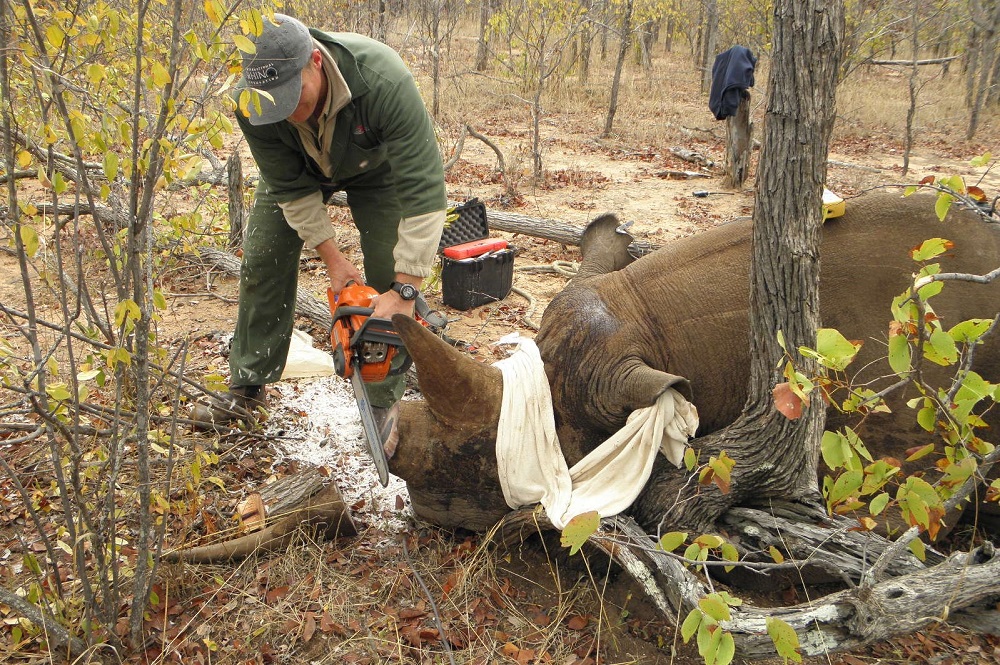What characterises a rhino? Some might say its huge size, immense power, thick legs, or prehistoric appearance. Many would say their horn. Yet, their horns are also the reason they are targeted by international crime syndicates. One strategy to protect rhinos from the urgent poaching threat is to carefully remove their horns through a process called dehorning. At a first glance, it would appear that this solves the problem: dehorned rhinos should no longer be poached. However, the issue is a lot more complex.
Dehorning rhinos was pioneered in Namibia in 1989. Between 1989 and the early 1990s, dehorning, coupled with rapid improvements in security and funding for anti-poaching, was perceived by stakeholders to have contributed significantly to reducing poaching losses. Throughout the 1990s, no dehorned rhinos were poached in Namibia.
There have been several other successful cases across Africa. In the Greater Kruger region of South Africa, a study looking at dehorning impact on poaching found it enabled a 78% reduction in incidents. In Zimbabwe, rhinos dehorned in certain Lowveld conservancies had a higher chance of surviving than horned animals.
However, there are examples where dehorning has not had the desired effect of significantly reducing, or stopping, poaching. In Zimbabwe’s Save Valley Conservancy, six newly dehorned rhinos were poached in January-August 2011 (one rhino was killed within 24 hours and another within five days of being dehorned). The high demand for and value of rhino horn means that, despite dehorning removing approximately 90% of horn, criminals may illegally kill a rhino for the remaining 10%.
It has been reported that some poaching gangs have illegally killed rhinos out of vengeance, in order to avoid tracking them again. If individuals pursuing rhinos to poach are moving through thick bush or hilly terrain, it may not be clear if a rhino has an intact horn before it is too late.
The dehorning procedure
Rhinos are usually darted from a helicopter (or occasionally from the ground in smaller reserves). Once the anaesthetic has set in, a ground team approaches and important checks are made and samples are taken, as well as the animal’s eyes and ears covered to prevent disturbance.
A pen is used to mark the point of horn removal, usually around 7cm from the base of the front horn and 5cm from the base of the back horn. A chainsaw or hand-saw is used to remove the rhino’s horns above these lines. Usually around 90-93% of horn is removed, being trimmed just above the germinal layer (an important cell layer that supports horn re-growth). The trimmed stump is smoothed and covered with Stockholm tar to prevent cracking and drying.
Rhinos’ horns grow continually, with some reports suggesting a white rhino’s horns can grow up to 7cm per year. To be an effective deterrent, experts recommend a rhino should be dehorned every 18-24 months. Yet, dehorning is an intrusive procedure and, like any immobilisation, there is a risk to the rhino each time it is given anaesthetic. The more frequently the rhinos are immobilised, the greater the risk.
In addition, dehorning is incredibly costly, due to the effort of finding the animals and the costs associated with the immobilisation process, especially if needed on a recurrent basis. The actual cost depends on several factors, but averages at approximately US $1,000 per animal.
Do rhinos need their horns?
Rhinos use their horns for several behavioural functions, including defending territories, protecting their calves, maternal care (including guiding calves) and foraging. Male rhinos also use their horns during disputes over territory or dominance.
An important consideration in the dehorning debate is the impact of dehorning on rhino behaviour.
Current research on the effects of dehorning on rhino behaviour is limited, and studies have shown varying results. One study found that dehorned black rhinos in 10 South African reserves reduced their home rangers and social interactions. However, a 2022 study based on black rhinos in Namibia found no evidence that dehorning had an effect on the animals’ age at first reproduction, inter calving intervals, birth sex ratios, calf survival rate, or overall lifespan. In Botswana, observations of nine white rhinos in the month before and after dehorning found no major changes in behaviour.
What happens to the removed horns?
The issue of dehorning leads to another ‘thorny issue’ – what should be done with the horns? These could be destroyed or kept at a secure location by the owners (whether these are private or a national government). However, this decision is often based upon the position of the owner on the future of a legal trade in rhino horn.
The current permit system for possessing, transporting and storing horns is often stringent and presents a security risk through the leakage of information on the whereabouts of horns in transit or at their final destination. In August 2023, 51 rhino horns were stolen from a stockpile held by South Africa’s North West Parks and Tourism Board.
Does dehorning save rhinos?
Studies show that poaching is an effective measure to protecting rhinos from the threat of organised crime syndicates. However, dehorning is only one part of an anti-poaching strategy. It must be coupled with extensive security and monitoring efforts. With an absence of security, rhinos may continue to be poached regardless of whether they have been dehorned.
Care must also be taken to approach dehorning operations at a broader level: dehorning rhinos in one area could simply displace the poaching threat to another.
Dehorning is not an easy or ‘quick fix’ solution, nor a standalone solution to keep rhinos safe. However, with careful planning and alongside other measures, it can offer some crucial breathing space for rhinos under threat and the rangers under huge pressure to protect them. As part of a wider strategy, dehorning provides a chance for teams to focus on other vital protection activities to boost long-term rhino conservation success.








